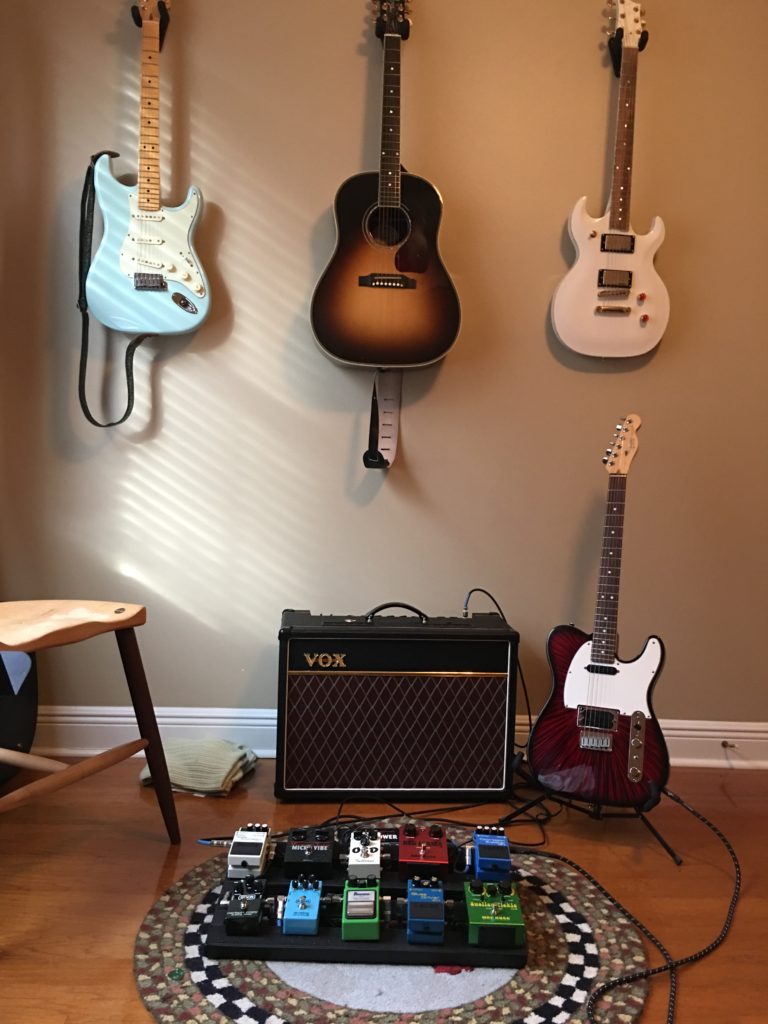Experimenting with Pedal Boards
Part I
By Andrew Bauman
After years of playing the acoustic guitar, I finally branched out a few years ago and bought my first electric guitar. My “starter” amp came with some built-in effects – distortion, overdrive, reverb, chorus and delay. Before long, I was interested in finding different sounds or trying to duplicate sounds from guitars in my favorite songs. And so… I began experimenting with effects pedals. A couple of years into it, I am still just scratching the surface. But I have learned a few things that might be helpful to anyone who may be thinking of, or doing, the same thing. Here are a couple of basic lessons I have learned that are worth passing along.
1. KISS – Keep It Simple Stupid
First, effects pedals are like fishing lures – most of them are flashy and are designed to catch more fisherman than fish. Don’t run out and buy the shiny pedal with the maximum number of flashing lights, knobs and sophisticated features. If you are just branching out into effects pedals, these pedals are way more than you need. You will spend more time messing, tweaking, tuning and fidgeting with knobs and buttons than playing, and you still won’t understand how the darn things work! If you do some research, some of the highest rated pedals are also the most simple. Many of these pedals have been around for 30 years for a reason. They are easy to use, they work and they give you a great sound. Save your money and start out with fairly straightforward, simple pedals.
2. Pedal Power
Second, while most pedals will take a 9-volt batter to power them, it’s best to connect them to a reliable power source. Battery power is probably best if you are transporting your pedal board a lot (most boards come with their own brief case to transport them). But if you are like me, you will forget to turn them all off when you get up to answer the phone or something. There’s nothing more annoying than sitting down to play, warming up your amp, tuning your guitar and then… changing 3 or 4 batteries. Most pedal battery cases are not snap-off – it involves a screwdriver. Also, the pedals are usually attached to the pedal board by adhesive velcro on the bottom. So, frequent battery changes are out of the question.
A power source is the way to go. There are a couple of different power sources. The One-Spot is a simple power source that plugs directly into the wall and has a chain of up to eight connectors for pedals. They are fairly cheap. However, the One-Spot is really only useful if you are using one or two (three tops) pedals at once. The more pedals you have on, the more the system has a problem evenly distributing the power and the effects will fade in and out. If you are going to use more than one or two pedals, it’s best to spend the money on a real power source, like the Voodoo Labs. These are converters that will run 8 or 10 pedals and deliver steady power to multiple pedals at once.
Note: This article continues in the article entitle “To Pedal or Not to Pedal – Part II”
Andrew Baumann, a fretmentor student and attorney by trade, contributed this article.



Great article. Even though I love acoustic guitar I’ve never quite been able to get in the right mindset to play electric. Learning to use some pedals feels like trying to learn a new instrument in itself sometimes, even if going with simpler true-bypass pedals rather than multi-effects boards. Will probably go back to it at some point though!